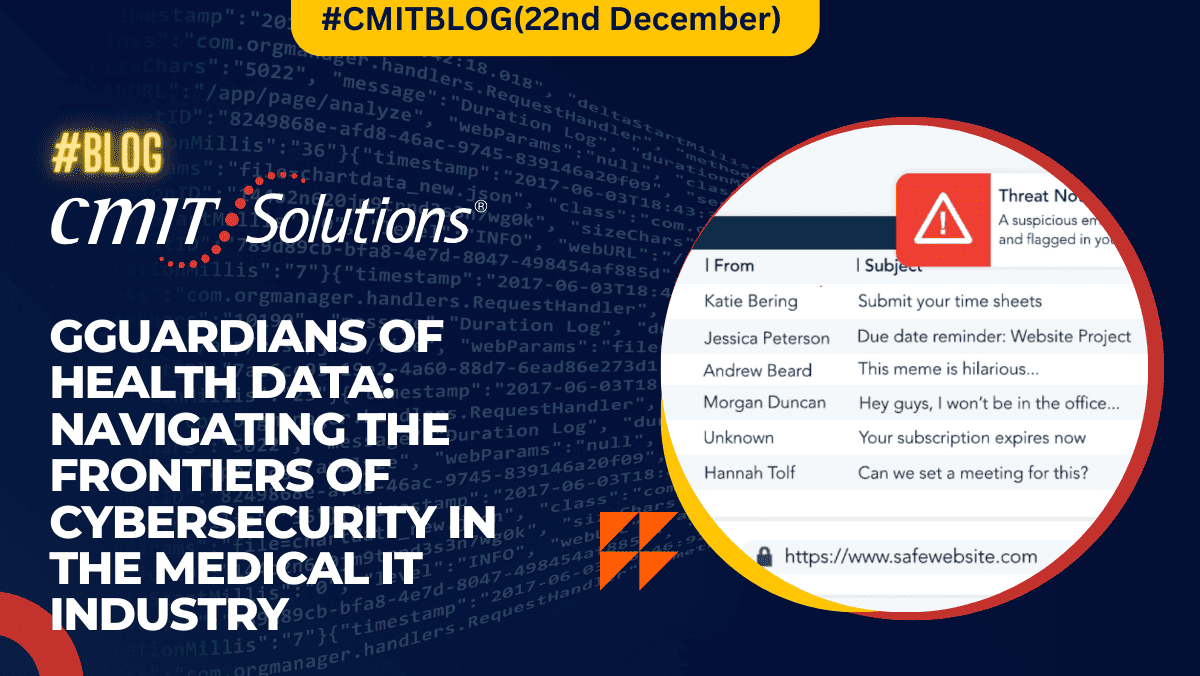Introduction
In the digital age, the intersection of cybersecurity and the medical IT industry is not just a technological necessity; it’s a matter of safeguarding sensitive health data and ensuring the integrity of healthcare systems. As medical records transition from paper to electronic formats, the need for robust cybersecurity measures becomes paramount. In this blog post, we’ll delve into the crucial role of cybersecurity in the medical IT industry, exploring the unique challenges, advancements, and the imperative of securing patient data in an increasingly connected healthcare landscape.
1. The Rise of Electronic Health Records (EHRs):
The transition from paper-based medical records to Electronic Health Records (EHRs) has streamlined healthcare processes but has also introduced new cybersecurity challenges. Protecting EHRs from unauthorized access, ensuring data integrity, and preventing data breaches are critical challenges in the digitalization of health records.
2. Patient Privacy and Confidentiality:
Patient privacy is a cornerstone of healthcare ethics, and safeguarding sensitive health information is a legal and ethical obligation for healthcare providers. Encryption, access controls, and robust authentication protocols are implemented to protect patient confidentiality and prevent unauthorized disclosure of health information.
3. IoT Devices in Healthcare:
*Integration:* The proliferation of Internet of Things (IoT) devices in healthcare, from wearable fitness trackers to medical monitoring devices, adds a layer of complexity to cybersecurity.
*Security Measures:* Securing communication channels, implementing device authentication, and regularly updating firmware are essential to prevent unauthorized access to IoT devices and protect against potential cyber threats.
4. Telemedicine and Cybersecurity Challenges:
The surge in telemedicine adoption brings convenience but also introduces cybersecurity challenges, including the secure transmission of patient data over virtual channels. Implementing secure video conferencing platforms, encrypting data in transit, and ensuring compliance with healthcare privacy regulations are crucial for telemedicine cybersecurity.
5. Ransomware Threats in Healthcare:
The healthcare industry is increasingly targeted by ransomware attacks, where cybercriminals encrypt critical data and demand payment for its release. Regular data backups, employee training on recognizing phishing attempts, and robust cybersecurity protocols help mitigate the impact of ransomware threats.
6. Compliance with Healthcare Regulations:
Healthcare providers must navigate a complex regulatory landscape, including the Health Insurance Portability and Accountability Act (HIPAA), to ensure compliance with data protection standards. Regular cybersecurity audits and assessments are conducted to assess compliance with healthcare regulations and identify areas for improvement.
7. Collaboration for Cyber Threat Intelligence:
Collaboration among healthcare organizations, industry partners, and cybersecurity experts is essential for sharing threat intelligence and staying ahead of emerging cyber threats. Ongoing training for healthcare professionals on cybersecurity best practices and recognizing potential security threats contributes to a culture of cyber awareness.
8. Emerging Technologies and Future Challenges:
The integration of Artificial Intelligence (AI) and Blockchain in healthcare introduces innovative solutions but also raises new cybersecurity considerations, including securing AI algorithms and maintaining the integrity of decentralized ledgers. Continued investment in cybersecurity research and development is crucial to staying ahead of evolving cyber threats and ensuring the resilience of medical IT systems.
Advantages of Cybersecurity in the Medical IT Industry:
1. Patient Data Protection:
Robust cybersecurity measures safeguard patient data, ensuring confidentiality, integrity, and availability of sensitive health information.
2. Compliance with Regulations:
Adhering to cybersecurity best practices helps healthcare providers comply with industry regulations such as HIPAA, fostering trust and avoiding legal consequences.
3. Prevention of Unauthorized Access:
Access controls, encryption, and strong authentication protocols prevent unauthorized access to electronic health records, protecting patient privacy.
4. Protection Against Ransomware:
Effective cybersecurity strategies, including regular data backups and employee training, help defend healthcare systems against ransomware attacks, minimizing the risk of data loss.
5. Secure Telemedicine Practices:
Implementing secure video conferencing platforms and encryption protocols ensures the confidentiality and privacy of patient information during telemedicine consultations.
6. Collaborative Threat Intelligence:
Collaborating with industry partners and cybersecurity experts enables the sharing of threat intelligence, helping healthcare organizations stay informed about emerging cyber threats.
7. Resilience Against Emerging Technologies:
Proactive investment in cybersecurity research and development prepares healthcare systems to address challenges posed by emerging technologies like AI and Blockchain.
8. Cultural Shift Towards Cyber Awareness:
Ongoing cybersecurity training for healthcare professionals fosters a culture of awareness, empowering staff to recognize and respond to potential cyber threats.
Disadvantages and Challenges:
1. Complex Regulatory Landscape:
Navigating the complex regulatory landscape, including HIPAA and other healthcare regulations, adds administrative burdens and compliance challenges for healthcare providers.
2. Cost of Implementation:
Implementing and maintaining robust cybersecurity measures can be financially burdensome for healthcare organizations, especially smaller practices with limited resources.
3. Human Factor Vulnerability:
The human factor remains a vulnerability, as cybersecurity is only as strong as the weakest link. Employee errors, such as falling victim to phishing attempts, pose ongoing challenges.
4. Evolution of Cyber Threats:
The constantly evolving nature of cyber threats requires healthcare organizations to stay vigilant and adapt their cybersecurity strategies to address new and sophisticated attack vectors.
5. Interoperability Challenges:
Ensuring seamless interoperability between different healthcare systems and devices while maintaining strong cybersecurity protocols can be technically challenging.
6. Limited Standardization:
Lack of standardized cybersecurity practices across the healthcare industry may result in inconsistencies in security measures, leaving some organizations more vulnerable than others.
7. Ethical Considerations in Emerging Technologies:
The integration of emerging technologies like AI and Blockchain raises ethical considerations, including algorithmic biases and ensuring the ethical use of decentralized ledgers.
8. Potential for Over-Reliance on Technology:
Over-reliance on technology may lead to a false sense of security, with healthcare professionals assuming that technology alone can address all cybersecurity challenges.
Conclusion
As the medical IT industry continues to evolve, the guardianship of health data through robust cybersecurity measures becomes an indispensable responsibility. Balancing the promise of digital innovation with the imperative of patient privacy requires a proactive and collaborative approach. By embracing advanced cybersecurity technologies, fostering a culture of cyber awareness, and adhering to regulatory standards, the medical IT industry can fortify its defenses against cyber threats, ensuring the continued trust and well-being of patients in the digital age.





